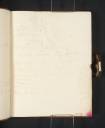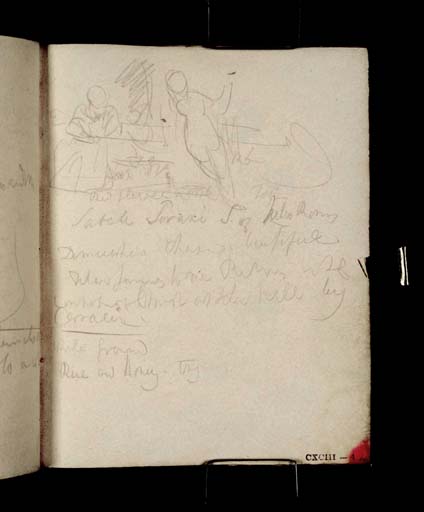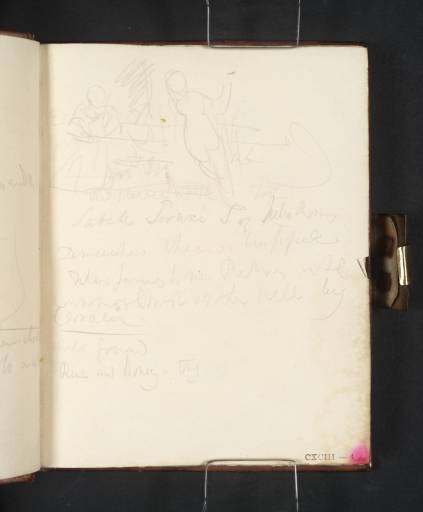Joseph Mallord William Turner Sketch of Titian's 'Sacred and Profane Love' in the Galleria Borghese, Rome, and Notes on Other Paintings 1819
Image 1 of 2
-
 Joseph Mallord William Turner, Sketch of Titian's 'Sacred and Profane Love' in the Galleria Borghese, Rome, and Notes on Other Paintings 1819
Joseph Mallord William Turner, Sketch of Titian's 'Sacred and Profane Love' in the Galleria Borghese, Rome, and Notes on Other Paintings 1819 -
 Joseph Mallord William Turner, Sketch of Titian's 'Sacred and Profane Love' in the Galleria Borghese, Rome, and Notes on Other Paintings 1819 (Enhanced image)Enhanced image
Joseph Mallord William Turner, Sketch of Titian's 'Sacred and Profane Love' in the Galleria Borghese, Rome, and Notes on Other Paintings 1819 (Enhanced image)Enhanced image
Joseph Mallord William Turner,
Sketch of Titian's 'Sacred and Profane Love' in the Galleria Borghese, Rome, and Notes on Other Paintings
1819
Joseph Mallord William Turner 1775–1851
Folio 5 Recto:
Sketch of Titian’s ‘Sacred and Profane Love’ in the Galleria Borghese, Rome, and Notes on Other Paintings 1819
D16768
Turner Bequest CXCIII 4
Turner Bequest CXCIII 4
Pencil on white wove paper, 115 x 94 mm
Inscribed by the artist in pencil ‘Red’, ‘Red flower on altar’, ‘[?Foot]’, within sketch. Also notes on paintings (see main catalogue entry)
Inscribed by John Ruskin in red ink ‘4’ bottom right
Stamped in black ‘CXCIII 4’ bottom right
Inscribed by John Ruskin in red ink ‘4’ bottom right
Stamped in black ‘CXCIII 4’ bottom right
Accepted by the nation as part of the Turner Bequest 1856
References
1909
A.J. Finberg, A Complete Inventory of the Drawings of the Turner Bequest, London 1909, vol.I, p.575, as ‘Slight sketch of Titian’s “Sacred and Profane Love”. “Red Sleeve. White Ground, Rue and Honey try (or tone)”, “Domenico Chase beautiful”, &c.’.
1969
John Gage, Colour in Turner: Poetry and Truth, London 1969, p.243 note 94.
1984
Cecilia Powell, ‘Turner on Classic Ground: His Visits to Central and Southern Italy and Related Paintings and Drawings’, unpublished Ph.D thesis, Courtauld Institute of Art, University of London 1984, pp.152, 155, 163, 433, as ‘Beneath Turner’s sketch of Sacred and Profane Love are some notes: Sa Jovani S of Julio Romano / Domenichino Chase beautiful / [i.e. P, I, 31] Titian (illegible) to the Rubens in the / (illegible) on the hill by / Carraci’ and reproduced pl.85 as ‘Notes and sketches relating to the paintings in Palazzo Borghese, Rome’.
1987
John Gage, J.M.W. Turner: ‘A Wonderful Range of Mind’, New Haven and London 1987, pp.60, 246 note 40.
1987
Cecilia Powell, Turner in the South: Rome, Naples, Florence, New Haven and London 1987, pp.65, 66, 203 notes 1, 3 and 5.
1990
Eric Shanes, Turner’s Human Landscape, London 1990, pp.143, 360 note 5.
1999
Gerald Finley, Angel in the Sun: Turner’s Vision of History, Montreal and Kingston [Canada] 1999, pp.115, 226 note 9.
2003
Ian Warrell, David Laven, Jan Morris and others, Turner and Venice, exhibition catalogue, Tate Britain, London 2003, pp.59, 262 note 41.
Titian (circa 1490–1576) was one of the Old Masters who represented a strong influence and challenge to Turner during his lifetime.1 The rough, schematic drawing in the top left-hand corner of this page represents a study of Titian’s, Sacred and Profane Love circa 1513–14, in the Galleria Borghese, Rome.2 Charlotte Eaton, who visited the Villa Borghese the year before Turner and published a popular travel account, Rome in the Nineteenth Century, first published in 1820, described the painting as follows:
But, out of Venice, I have seen nothing of Titian’s to compare to his Sacred and Profane Love, which is here. It represents two figures, – one a heavenly and youthful form, unclothed, except with a light drapery – the other, a lovely female, dressed in the most splendid attire; both are sitting on the brink of a well, into which a little winged Love is groping, apparently to find his lost dart. Description can give you no idea of the consummate beauty of this beautiful composition. It has all Titian’s matchless warmth of colouring, – with a correctness of design no other painter of the Venetian School ever attained.3
An additional related sketch depicting part of the background of Titian’s painting can be found on folio 4 verso (D16767; Turner Bequest CXCIII 3a).
John Gage has suggested that Turner may have received a personal recommendation to view Titian’s picture from his friend, the Scottish artist, Hugh ‘Grecian’ Williams (1773–1829), whom he met in Scotland in 1818.4 Williams described it as a ‘faultless’ piece of colouring and Turner no doubt agreed.5 At some point he acquired a copy of part of the painting which he kept in his studio, suggesting a profound and personal connection to the image.6 Echoes of the symbolic elements of the composition such as the hare or rabbit being chased by hounds, and the sarcophagus in the foreground, may be reflected by similar elements within Turner’s later historical oil paintings such as Bay of Baiae, with Apollo and the Sibyl 1823 (Tate, N00505), and The Golden Bough, 1834 (Tate).7 Gerald Finley has also remarked upon the similarity of the dress worn by the woman on the left of Titian’s painting to that of the figure of La Fornarina in Turner’s Rome, from the Vatican 1820 (Tate, N00503).8
Also on the sheet are handwritten notes relating to other paintings in the Galleria Borghese. The inscription reads as follows: ‘Sa[?nti] Jovani S of Julio Romano | Domenichino Chase, beautiful | Titian famous to the Rubens in the | Company of Christ on the hill by | Carraci. | White ground | Rue and Honey. try.’9 Turner may possibly be referring to the following works of art: one of a number of images of the Virgin and Baby Jesus with St John by Giulio Romano (circa 1499–1546);10 Domenichino’s (1581–1641) Hunt of Diana 1617–18,11, Rubens (1577–1640, Lamentation over the Dead Christ, 1602;12 as well as a painting by Agostino Carracci (1557–1602), or his son, Antonio Carracci (1583–1618). The phrase ‘white ground’ may refer to Titian, and reflects Turner’s own interest in a technique which he had been using in his practice since around 1805.13 For further notes and studies relating to the Galleria Borghese see folio 2 verso (D16765).
Nicola Moorby
February 2011
See Martin Butlin ‘Titian’ in Evelyn Joll, Martin Butlin and Luke Herrmann (eds.), The Oxford Companion to J.M.W. Turner, Oxford 2001, p.338, and David Solkin (ed.), Turner and the Masters, exhibition catalogue, Tate Britain, London 2009, pp.134–5, 138–41.
How to cite
Nicola Moorby, ‘Sketch of Titian’s ‘Sacred and Profane Love’ in the Galleria Borghese, Rome, and Notes on Other Paintings 1819 by Joseph Mallord William Turner’, catalogue entry, February 2011, in David Blayney Brown (ed.), J.M.W. Turner: Sketchbooks, Drawings and Watercolours, Tate Research Publication, December 2012, https://www

